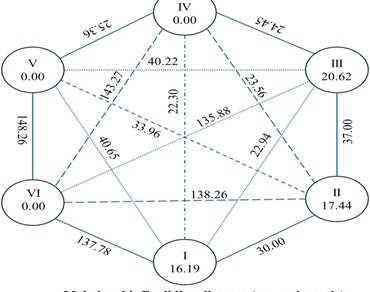Genetic diversity and inter-relationship between different traits in diverse leafy mustard (Brassica juncea var. rugosa) genotypes’
*Article not assigned to an issue yet
Research Articles | Published: 27 December, 2024
First Page: 0
Last Page: 0
Views: 2048
Keywords: Genetic diversity, Mustard, Cluster, D2 statistic
Abstract
Leafy Mustard (Brassica juncea var. rugosa) is a well liked leafy vegetable grown in plains as well as hills of Northern India. 31 Mustard genotypes and released varieties were evaluated to devise the extent of genetic diversity. These genotypes were sown in randomized block design with three replications in field and data were observed for seventeen characters. Analysis of coefficient of variation unveiled significant differences among all the genotypes for all the characters. The Cluster analysis distributed the 31 genotypes into 6 different clusters based on genetic distance. The D² analysis showed the highest intra cluster distance in cluster III (451.92) having 5 genotypes and the highest inter cluster distance (20529.11) among genotypes. Both Cluster V and cluster VI have one genotype. The higher inter-cluster distances than the intra-cluster distances designated wider genetic diversity of different groups among the genotypes. Clusters V and VI were strikingly diverse from the rest of the clusters (inter-cluster D-value = 148.26). For green leaf yield per plant, Cluster II exhibited the highest mean value of 290.66 g, while Cluster VI had the lowest mean of 253.33 g. The green leaf yield per hectare varied from 328.33 q/ha in Cluster VI to 372.00 q/ha in Cluster V. Cluster III had the highest mean value for protein content at 29.02.Thus, with these outcome, we can affirm that these genotypes were promising and can be utilized for future amelioration programme in leafy mustard.

References
Adhikari A, Punetha H (2024) Comprehensive Assessment of Brassica juncea variety rugosa (Pahari Rai) Accessions from the Sub-Himalayan Region: Phytochemical, Antioxidant, Enzymatic, Mineral, and Fatty Acid Profiling. Res Square 1–19. https://doi.org/10.21203/rs.3.rs-4340286/v1
Anonymous (2015) Agricultural statistics at a glance. Directorate of Economics and Statistics, Department of agriculture, Co-operative and Farmers Welfare. Pp 122
Arunachalam V, Bandyopadhyay A, Nigam SN, Gibbons RW (1984) Heterosis in relation to genetic divergence and specific combining ability in groundnut (Arachis hypogaea L). Euphytica 33:33–39
Bhandari D, Singh A (2023) Genetic Divergence in Leafy Mustard (Brassica juncea var.rugosa) Germplasm Grown under Tarai Condition of Uttarakhand. Indian J agricultural Res 57(4):448–452
Ghorbani H (2019) Mahalanobis distance and its application for detecting multivariate outliers. Facta Univ Ser Math Inf 34:583–595. 10.1093/ bioinformatics/btv428
Gupta VP, Sekhon MS, Satija DR (1991) Studies on genetic diversity, heterosis and combining ability in Indian Mustard (Brassica juncea L). Indian J Genet Plant Breed 51(4):448–453
Kant L, Gulati SC (2001) Genetic analysis for yield and its components and oil content in Indian mustard [B. juncea (L.) Czern & Coss]. Indian J Genet 61:37–40
Mahalanobis PC (1936a) Mahalanobis distance. In Proceeding National Institute of Science of India, 49(2): 234–256
Mahalanobis PC (1936b) Studies on the Generalized Distance in Statistics. In: Proceedings of Institute of Science, India.2: 49–55
Meena HO, Meena PKP, Singh K, Meena HP, Meena D (2020) Genetic divergence analysis in Indian mustard[Brassica juncea (L.) Czern and Coss]. Int J Curr Microbiol Appl Sci 9(10):2185–2192
Naznin S, Kawochar MA, Sultana S, Zeba N, Bhuiyan SR (2015) Genetic divergence in Brassica rapa L. Bangladesh J Agricultural Res 40(3):421–433
Pankaj R, Avtar R, Kumari Nisha J, Minakshi R, Babita, Manmohan, Sheoran RK (2017) Multivariate analysis in Indian mustard genotypes for morphological and quality traits Electronic. J Plant Breed 8(2):450–458
Pant U, Bhajan R, Singh Anita, Kulshesthra K, Singh AK, Punetha H (2020) Green leafy mustard: A healthy alternative. E J Plant Breed 11(01):267–270. https://doi.org/10.37992/2020.1101.045
Parajuli A (2015) Cultivation and Management practices of leafy vegetable in Nepal. Wordpress.com.https://parajulianish.wordpress.com/2015/02/13/cultivation-and-management-practices-of-leafy-vegetables-in-nepal/ Accessed 13 Feb 2015
Rabbani MA, Iwabuchi A, Murakami Y, Suzuki T, Takayanagi K (1998) Phenotypic variation and the relationships among mustard (Brassica juncea L). germplasm Pakistan Euphytica 101:357–366
Rao CR (1952) Advance statistical methods in biometrical research. Wiley, Oxford,England, pp 40–51
Rao VR, Hodgkin T (2002) Genetic diversity and conservation and utilization of plant genetic resources. Planr Cell Tissue Organ Cult 68(1):1–19
Rauniyar K, Bhattarai BP (2017) Growth, yield and soil nutrient status of broad leaf mustard (Brassica juncea var. rugosa) under integrated nutrientmanagement. Nepal J Agri Sci 15:98–106
Rout S, Das A, Sur B, Umamaheswar N, Sadhu S, Ghimiray TS, Mondal HA, Hijam L, Chakraborty M, Roy (2019) SK Genetic divergence in Indian mustard [Brassica juncea (L.) Czern and Coss] under sub-Himalayan region. Journal of Crop and Weed 15(2): 18–24
Salgotra RK, Gupta BB, Bhat JA, Sharma S (2015) Genetic diversity and population structure of basmati rice (Oryza sativa L.) germplasm collected from north-western Himalayas using trait linked SSR markers. PLoS ONE 10:e0131858. https://doi.org/10.1371/journal.pone.0131858
Saroj R, Soumya SL, Singh S, Sankar S, Mukesh C, Rajat Y, Navinder S, Sujata V, Yadava Devendra K (2021) Unravelling the Relationship Between Seed Yield and Yield-Related Traits in a Diversity Panel of Brassica juncea Using Multi-Traits Mixed Model Frontiers. Plant Sci 12:1–16
Author Information
Department of Vegetable Science, G.B. Pant University of Agriculture and Technology, Pantnagar, India